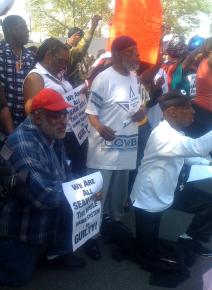“We are all Sean Bell”
By
NEW YORK--Coordinated acts of nonviolent civil disobedience took place at six different locations across the city May 7 in a protest against the not-guilty verdict for three police officers who shot and killed an unarmed Sean Bell with 50 bullets.
The actions blocked major tunnels and bridges, disrupting rush-hour traffic. More than 200 protesters were arrested, and hundreds more participated.
The protests were coordinated by Rev. Al Sharpton and the National Action Network and took place on the heels of other demonstrations in the last two weeks, starting the day the verdicts were announced. The acts of civil disobedience were announced as "pray-ins" and are meant to be the first in a series of escalating protests.
"If you're not going to lock up the guilty in this town, then I guess you're going to have to lock up the innocent," Sharpton said in his call for the protest. "Since we won't lock up the cops, then lock up those that are fighting for justice."
At One Police Plaza, 1,000 protesters gathered to demonstrate and support those engaging in acts of civil disobedience. About 50 protesters were arrested as they sat down in front of an entrance to the Brooklyn Bridge. Sharpton; Sean Bell's fiancee, Nicole Paultre-Bell; and Joseph Guzman and Trent Benefield, who were shot with Sean Bell; were among the arrested.

Protesters participated in spirited chants of "We are all Sean Bell, NYPD go to hell!" and "No justice, no peace! Fire racist police!"
"We aren't going to let our people get slaughtered," said activist and organizer Amos Hughes. "People can say we need to respect the verdict, but I say we don't have democracy." He added, "Black people don't have rights--only the right to remain silent."
Despite the billing of the actions as "pray-ins," the pent-up anger over the verdict spilled over, expressing itself in the form of angry chanting and, in some locations, spontaneous takeovers of streets and mass occupations of intersections and bridge entrances.
In Brooklyn, a crowd of 200 people gathered in front of a church and marched to the Brooklyn Bridge and Manhattan Bridge, led by New York City councilman and former Black Panther Charles Barron.
During the march, protesters received honks of support from cars stuck in traffic. Others from the community joined the march, with the crowd swelling to 500 at the demonstration's height.
When the protest reached Manhattan Bridge, demonstrators blocked all traffic into and out of Brooklyn for one-and-a-half hours, until police took into custody activists who had agreed to be arrested ahead of time.
ON THE streets of East Harlem, a spirited crowd of 400 protesters marched to the Triborough Bridge. On the way, protesters spontaneously occupied two major intersections, chanting "Whose streets? Our streets!"
When the march reached the entrance to the bridge, several dozen protesters sat down in front of three ramps leading to and from the bridge, while the remainder stood by those planning to get arrested.
Cory Wise, a wrongly accused and exonerated defendant in the Central Park jogger case in the 1990s, was among those arrested. Moments before his arrest, he said, "I was in a situation like this with the police. So right now, I call myself a freedom fighter."
When police officers arrested those sitting down, protesters began chanting, "Let them go!" and "The whole world is watching!" The police hoped the arrests would lead to a peaceful dispersion of the crowd. However, between 100 and 150 protesters continued to occupy the entrances and exits of the bridge for another 30 minutes, in spite of the threats of police officers.
At one point, a man in a motorized wheelchair parked directly in front of a mattress truck attempting to turn onto the entrance to the bridge and refused to leave. This allowed protesters to march back and forth in the intersection for several more minutes before this man was arrested as well.
Finally, police officers lined up and used orange meshing to direct--and at times, push--the crowd out of the intersection. Demonstrator Janice Walker yelled out, "Is that for the cattle?"
The march continued even after this, occupying several more intersections. At one, demonstrators brought out a long jump rope and took turns while the crowd chanted their jumps from 1 to 50.
There are plans to continue protests every week. Upon his release from jail, Sharpton said, "This is the beginning of the Sean Bell movement...I said today would be the slow down, leading to the shut down."
Those who came out were inspired by the demonstration and by being able to express their outrage with others. As one demonstrator, a Harlem man whose son recently returned from Iraq, said in an interview, "We're going to take it to the whole city."
Future actions called by the National Action Network promise to provide more opportunities to broaden and deepen this movement against police brutality. The popular chant "We are all Sean Bell" demonstrated the feeling that the ongoing string of police murders must be stopped.
As Janice Walker said, "I have a Black son. I don't want my son shot on his wedding night."


